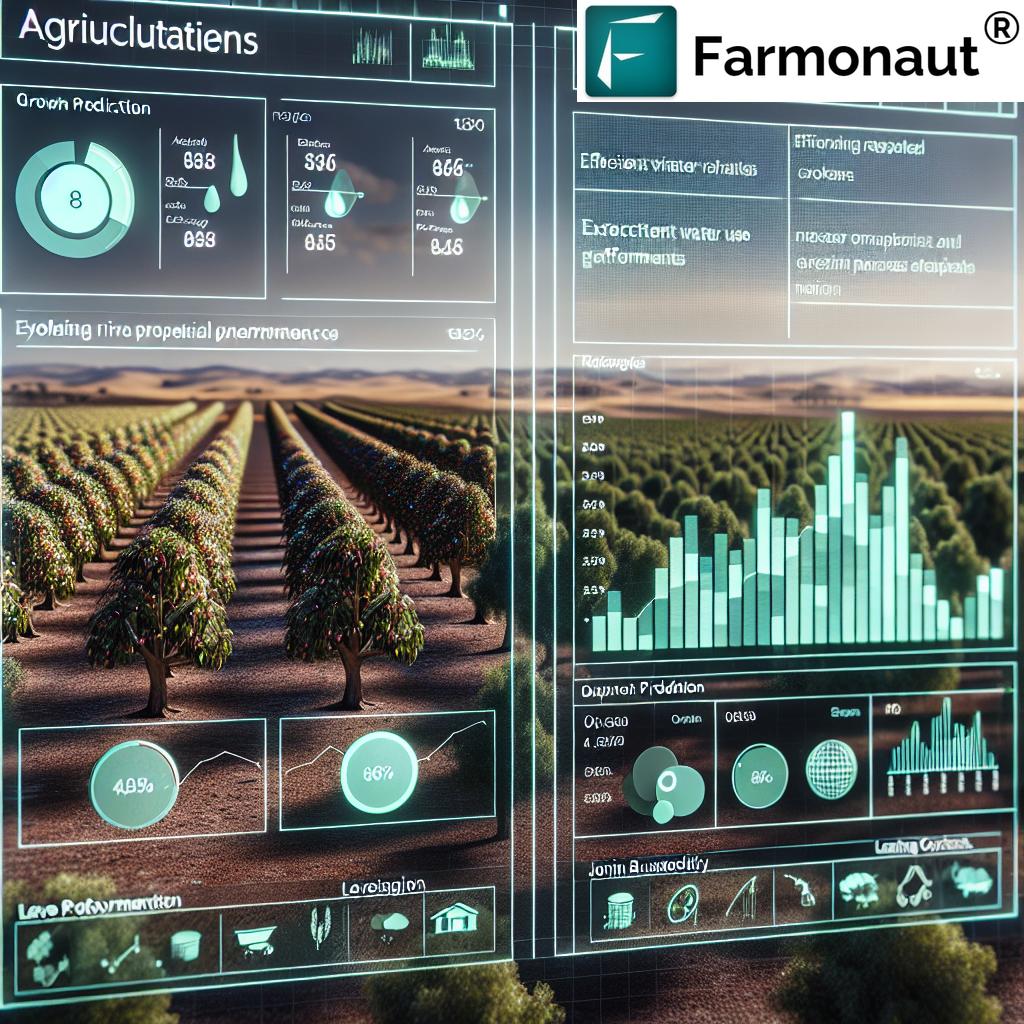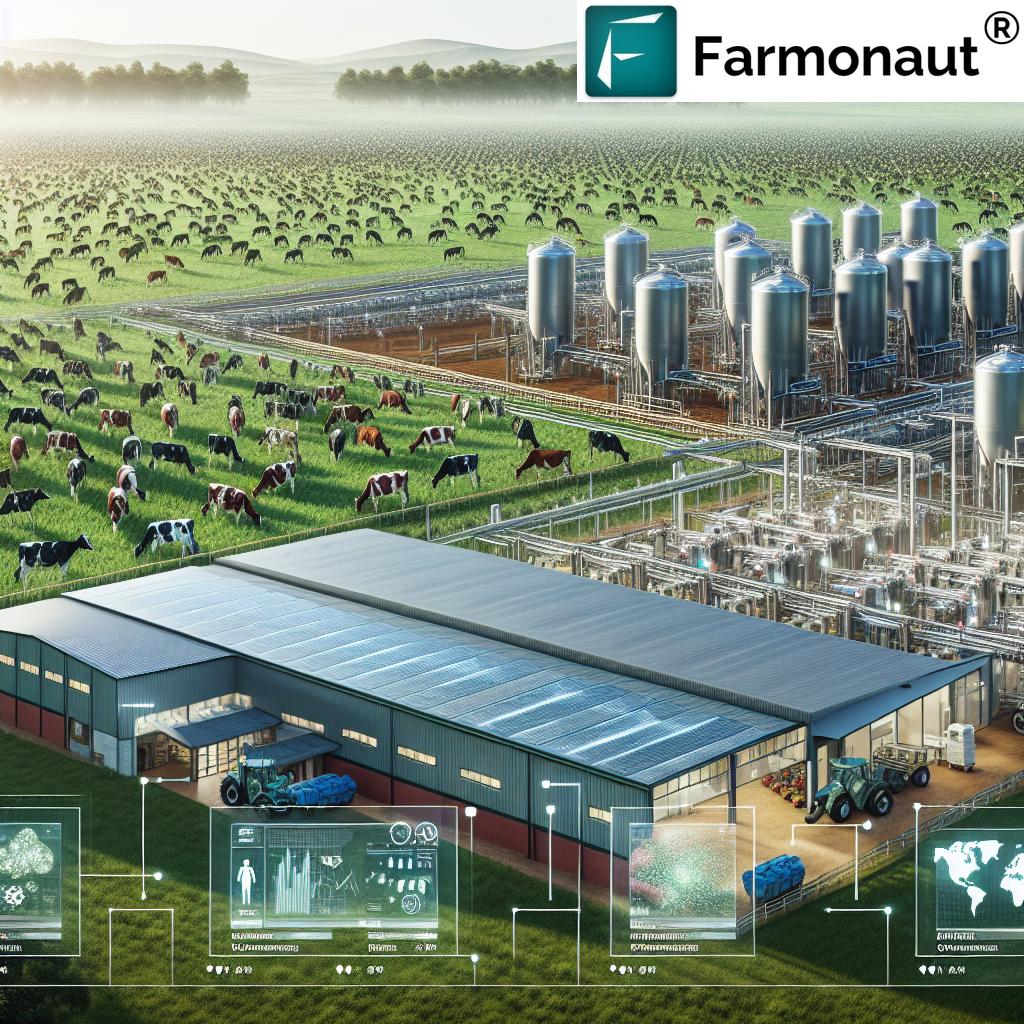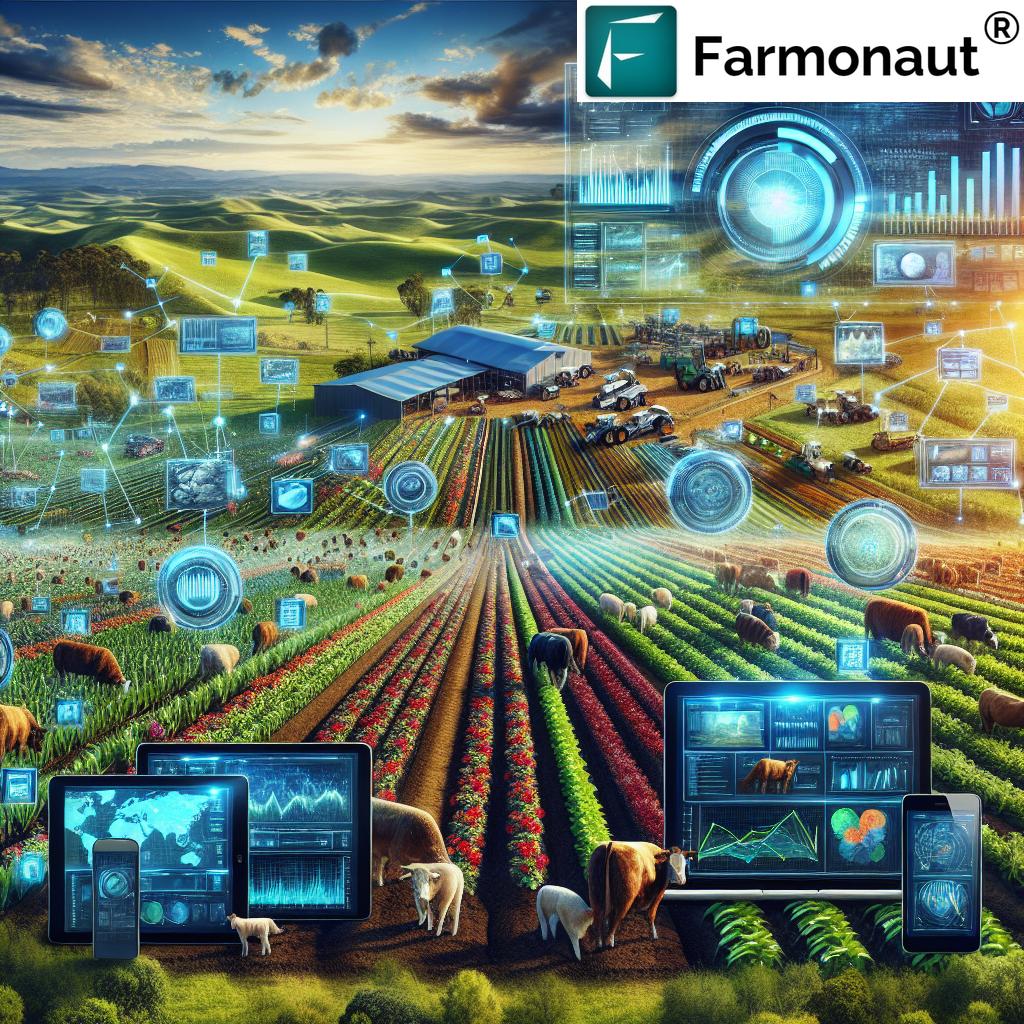Maximizing Agricultural Investments: Expert Valuation and Forecasting for Australian Rural Properties
“Australian agricultural asset management spans a $2.0 billion portfolio across five key sectors: almonds, cattle, vineyards, cropping, and macadamias.”
In the vast and diverse landscape of Australian agriculture, the potential for investment and growth is as expansive as the country itself. As we delve into the world of agricultural asset management and sustainable farming practices, we uncover a wealth of opportunities that are reshaping Australian agribusiness investment. From the sun-drenched almond orchards to the sprawling cattle stations, and from the prestigious vineyards to the innovative cropping enterprises, Australia’s rural properties offer a cornucopia of investment prospects.
In this comprehensive guide, we’ll explore the intricacies of agricultural property valuation, focusing on a substantial $2.0 billion portfolio that spans five pivotal sectors: almonds, cattle, vineyards, cropping, and macadamias. We’ll unravel the complexities of crop revenue forecasting and examine the critical role of water entitlements in rural property management. Our journey will take us from the renowned Barossa vineyards to the vast cattle stations near Rockhampton, offering insights into orchard development, feedlot operations, and cutting-edge irrigation systems.

We’ll also explore the potential of joint ventures with institutional investors and how a diversified agricultural portfolio can yield robust returns. Whether you’re intrigued by macadamia orchard development or considering vineyard investment in Australia, this guide offers valuable insights into the dynamic landscape of rural assets and lease management.
Moreover, we’ll showcase how innovative technologies, such as those offered by Farmonaut, are revolutionizing agricultural forecasting and property valuation across the nation. By leveraging satellite imagery and advanced analytics, these tools are empowering investors and farmers alike to make more informed decisions and optimize their agricultural operations.
The Australian Agricultural Landscape: A Fertile Ground for Investment
Australia’s agricultural sector is a powerhouse of productivity and innovation, offering a diverse range of investment opportunities across its vast and varied terrain. From the tropical north to the temperate south, the country’s rural properties present a tapestry of possibilities for astute investors and agricultural entrepreneurs.
- Almonds: With growing global demand, almond orchards in regions like Hillston and Mildura are attracting significant investment.
- Cattle: Extensive pastoral lands in Queensland and the Northern Territory support a thriving beef industry.
- Vineyards: Prestigious wine regions such as the Barossa Valley and Adelaide Hills continue to produce world-class wines and investment opportunities.
- Cropping: Broadacre farming in areas like New England and the Western Australian wheatbelt offers scale and diversity.
- Macadamias: The subtropical climates of northern New South Wales and Queensland are ideal for this high-value nut crop.
Each of these sectors presents unique challenges and opportunities, requiring a nuanced approach to valuation, forecasting, and management. As we explore these areas in depth, we’ll uncover the key factors that drive success in Australian agribusiness investment.
Agricultural Property Valuation: The Cornerstone of Smart Investments
Agricultural property valuation is a complex and multifaceted process that forms the foundation of any sound investment strategy in the rural sector. It requires a deep understanding of not only the land and its productive capacity but also the broader economic, environmental, and market factors that influence its value.
Key considerations in valuing agricultural properties include:
- Soil quality and productive capacity
- Water availability and agricultural water entitlements
- Climate suitability for specific crops or livestock
- Infrastructure and improvements
- Proximity to markets and transportation networks
- Historical yield data and future production potential
Investors and property managers must also consider the potential for value-adding activities, such as vertical integration or the implementation of new technologies that can enhance productivity and sustainability.
Farmonaut’s advanced satellite-based technology plays a crucial role in modern agricultural property valuation. By providing real-time data on crop health, soil moisture, and other critical metrics, Farmonaut enables more accurate and dynamic valuations. This technology allows investors to:
- Monitor crop health and productivity across large areas
- Assess the efficacy of irrigation systems and water management practices
- Identify areas for improvement or development within a property
- Track historical performance and predict future yields
By incorporating these advanced tools into the valuation process, investors can make more informed decisions and better understand the true potential of rural properties.
Crop Revenue Forecasting: Predicting Success in Agriculture
Crop revenue forecasting is an essential skill in agricultural asset management, providing investors and farm managers with crucial insights into potential returns and cash flow. This process involves a blend of historical data analysis, current market conditions, and predictive modeling to estimate future crop yields and prices.
Key components of effective crop revenue forecasting include:
- Analysis of historical yield data
- Assessment of current crop health and growth stages
- Evaluation of market trends and commodity prices
- Consideration of weather patterns and climate forecasts
- Understanding of input costs and operational expenses
Farmonaut’s satellite-based crop monitoring system enhances the accuracy of revenue forecasting by providing real-time data on crop health and development. This technology allows for more precise yield predictions and helps identify potential issues that could impact productivity.

“Strategic water entitlements play a crucial role in rural property management, impacting agricultural investments from Barossa vineyards to Rockhampton cattle stations.”
Water Entitlements: The Lifeblood of Australian Agriculture
Agricultural water entitlements are a critical factor in the valuation and management of rural properties across Australia. In a country where water scarcity is a persistent challenge, the ability to access and efficiently use water resources can make or break an agricultural investment.
The importance of water entitlements varies across different agricultural sectors:
- Almonds and Macadamias: High water requirements make entitlements crucial for orchard viability.
- Vineyards: Strategic irrigation is essential for producing high-quality grapes, particularly in premium wine regions.
- Cropping: Access to irrigation can significantly boost yields and allow for crop diversification.
- Cattle: While less water-intensive than horticulture, reliable water sources are vital for livestock health and pasture management.
Investors must carefully consider the water entitlements associated with a property, including:
- Volume and reliability of allocations
- Type of entitlement (high or low security)
- Potential for trading or leasing water rights
- Infrastructure for water delivery and storage
- Long-term sustainability of water resources in the region
Farmonaut’s technology aids in water management by providing insights into soil moisture levels and crop water requirements, enabling more efficient use of this precious resource.
Diversification Strategies in Agricultural Investment
A diversified agricultural portfolio is key to managing risk and maximizing returns in the rural property sector. By spreading investments across different agricultural sectors, regions, and property types, investors can mitigate the impacts of market fluctuations, climatic events, and sector-specific challenges.
Strategies for diversification include:
- Geographic diversification across different climatic zones
- Sector diversification (e.g., combining livestock and cropping enterprises)
- Product diversification within sectors (e.g., different grape varieties in vineyards)
- Operational diversification (e.g., integrating value-adding activities)
For example, an investor might combine:
- Almond orchards in Sunraysia, Victoria
- Cattle stations near Rockhampton, Queensland
- Vineyards in the Barossa Valley, South Australia
- Cropping land in the New England region of New South Wales
- Macadamia orchards in Bundaberg, Queensland
This diverse portfolio would provide exposure to different markets, climates, and production cycles, helping to balance risks and opportunities.
Sustainable Farming Practices: The Future of Australian Agriculture
Sustainable farming practices are increasingly important in Australian agriculture, not only for environmental stewardship but also for long-term profitability and asset value. Investors and farm managers are recognizing that sustainable practices can enhance productivity, reduce input costs, and improve resilience to climate variability.
Key sustainable farming practices include:
- Conservation tillage and stubble retention in cropping systems
- Precision agriculture techniques for efficient resource use
- Integrated pest management to reduce chemical inputs
- Rotational grazing systems for improved pasture management
- Water-efficient irrigation technologies
- Carbon sequestration through improved soil management
Farmonaut’s technology supports sustainable farming by providing detailed insights into crop health and resource utilization, enabling farmers to optimize inputs and reduce waste. This not only improves profitability but also enhances the long-term value and sustainability of agricultural assets.
Joint Ventures and Institutional Investors in Australian Agriculture
The Australian agricultural sector is increasingly attracting interest from institutional investors, both domestic and international. These investors bring significant capital and often seek partnerships with experienced local operators through joint ventures.
Benefits of joint ventures in agriculture include:
- Access to capital for property improvements and expansion
- Sharing of operational expertise and market knowledge
- Risk mitigation through shared investment
- Potential for vertical integration and value chain improvements
For example, a joint venture might involve an institutional investor partnering with a local farming family to expand and modernize a cattle station near Rockhampton. The investor provides capital for infrastructure improvements and herd expansion, while the local partner contributes operational expertise and on-the-ground management.
Technology and Innovation in Agricultural Asset Management
The integration of technology and innovation is transforming agricultural asset management in Australia. From precision agriculture to advanced data analytics, these tools are enhancing productivity, sustainability, and profitability across the sector.
Key technological advancements include:
- Satellite-based crop monitoring and yield prediction
- Automated irrigation systems and soil moisture sensors
- Drones for property surveying and crop assessment
- Big data analytics for informed decision-making
- Blockchain technology for supply chain traceability
Farmonaut is at the forefront of this technological revolution, offering advanced satellite-based farm management solutions. Their platform provides valuable services such as real-time crop health monitoring, AI-based advisory systems, and resource management tools, empowering investors and farm managers to make data-driven decisions.
To explore Farmonaut’s innovative solutions, visit their web application or download their mobile apps:
For developers interested in integrating Farmonaut’s technology into their own systems, explore the API and API Developer Docs.
Australian Agricultural Investment Sectors Comparison
| Sector | Estimated Portfolio Value (in millions AUD) | Primary Regions | Water Entitlement Importance | Typical Investment Horizon | Revenue Forecasting Complexity | Sustainable Farming Practices Adoption | Joint Venture Potential |
|---|---|---|---|---|---|---|---|
| Almonds | 400 | Sunraysia, Riverina | High | Long-term | Medium | High | High |
| Cattle | 600 | Queensland, Northern Territory | Medium | Medium-term | Medium | Medium | High |
| Vineyards | 300 | Barossa, Adelaide Hills, Margaret River | Medium | Long-term | High | High | Medium |
| Cropping | 500 | New England, Western Australian Wheatbelt | Medium | Short to Medium-term | High | High | Medium |
| Macadamias | 200 | Northern NSW, Bundaberg | High | Long-term | Medium | High | High |
Rural Property Lease Management: Maximizing Returns
Rural property lease management is a critical aspect of agricultural asset management, offering opportunities for both landowners and operators to optimize their returns. Effective lease structures can align the interests of property owners and farmers, promoting sustainable land use and long-term value appreciation.
Key considerations in rural property lease management include:
- Lease duration and renewal options
- Rent calculation methods (fixed, variable, or hybrid)
- Responsibilities for property improvements and maintenance
- Performance incentives for sustainable farming practices
- Risk-sharing mechanisms for climatic events or market fluctuations
For example, a vineyard investment in the Barossa Valley might employ a long-term lease with a base rent plus a percentage of grape sales. This structure incentivizes both the landowner and the operator to invest in vineyard quality and productivity.
The Role of Capex in Agricultural Asset Enhancement
Capital expenditure (Capex) plays a crucial role in enhancing the value and productivity of agricultural assets. Strategic investments in infrastructure, equipment, and technology can significantly improve operational efficiency and asset value.
Key areas for Capex in agriculture include:
- Irrigation infrastructure and water storage facilities
- Feedlot development for cattle operations
- Orchard establishment and replanting programs
- Processing and packing facilities for value-adding
- Precision agriculture technology and farm management software
For instance, investing in advanced irrigation systems in an almond orchard near Hillston can improve water use efficiency, boost yields, and enhance the property’s overall value. Similarly, developing a state-of-the-art feedlot near Rockhampton can increase the carrying capacity and profitability of a cattle station.
Energy Efficiency and Renewable Energy in Agriculture
Energy management is becoming increasingly important in agricultural operations, both for cost reduction and environmental sustainability. Investments in energy efficiency and renewable energy can provide long-term benefits for rural properties.
Opportunities for energy optimization in agriculture include:
- Solar-powered irrigation systems
- Biogas production from agricultural waste
- Wind energy for remote properties
- Energy-efficient machinery and equipment
- Smart grid technologies for optimized energy use
For example, a large-scale cropping operation in the New England region might invest in a combination of solar panels and battery storage to power irrigation systems and reduce reliance on grid electricity. This not only reduces operating costs but also enhances the property’s sustainability credentials.
Conclusion: The Future of Australian Agricultural Investment
As we’ve explored throughout this comprehensive guide, the landscape of Australian agricultural investment is rich with opportunity and ripe for innovation. From the almond orchards of Sunraysia to the cattle stations of Rockhampton, and from the prestigious vineyards of the Barossa to the diverse cropping enterprises of New England, Australia’s rural properties offer a wealth of investment prospects.
The key to success in this dynamic sector lies in:
- Thorough and accurate agricultural property valuation
- Sophisticated crop revenue forecasting techniques
- Strategic management of water entitlements
- Adoption of sustainable farming practices
- Leveraging technology for enhanced productivity and decision-making
- Exploring joint ventures and partnerships with institutional investors
- Effective rural property lease management
- Strategic capital expenditure for asset enhancement
As we look to the future, the integration of advanced technologies like those offered by Farmonaut will play an increasingly crucial role in optimizing agricultural operations and investment decisions. By combining traditional farming wisdom with cutting-edge satellite imagery, AI-driven insights, and data analytics, investors and farm managers can make more informed decisions, improve productivity, and drive sustainable growth in the agricultural sector.
The future of Australian agriculture is bright, with opportunities for those who can navigate the complexities of the sector and harness the power of innovation. Whether you’re considering macadamia orchard development in Bundaberg or vineyard investment in the Adelaide Hills, the key to success lies in a comprehensive understanding of the market, a commitment to sustainability, and the strategic use of technology to drive efficiency and profitability.
As we continue to face global challenges such as climate change, population growth, and increasing demand for food and fiber, Australian agriculture is well-positioned to play a pivotal role in meeting these challenges. By embracing sustainable practices, leveraging advanced technologies, and fostering innovation, the Australian agricultural sector can continue to thrive, offering attractive investment opportunities while contributing to global food security and environmental stewardship.
FAQ Section
Q: What are the key factors to consider when valuing agricultural properties in Australia?
A: Key factors include soil quality, water availability and entitlements, climate suitability, infrastructure, proximity to markets, historical yield data, and future production potential. Advanced technologies like Farmonaut’s satellite imagery can provide additional insights into crop health and land productivity.
Q: How important are water entitlements in Australian agricultural investments?
A: Water entitlements are crucial, especially in water-intensive sectors like almonds and macadamias. They significantly impact property values and operational viability. Investors should carefully assess the volume, reliability, and type of water entitlements associated with a property.
Q: What role does technology play in modern agricultural asset management?
A: Technology is transforming agricultural management through precision agriculture, satellite-based crop monitoring, automated irrigation systems, and data analytics. These tools enhance productivity, sustainability, and profitability by providing real-time insights and enabling data-driven decision-making.
Q: How can investors diversify their agricultural portfolios in Australia?
A: Diversification strategies include investing across different geographic regions, agricultural sectors (e.g., livestock, cropping, horticulture), and operational models. This approach helps mitigate risks associated with climate variability, market fluctuations, and sector-specific challenges.
Q: What are the benefits of joint ventures with institutional investors in agriculture?
A: Joint ventures can provide access to significant capital for property improvements and expansion, share operational expertise and market knowledge, mitigate risks through shared investment, and potentially enable vertical integration and value chain improvements.















